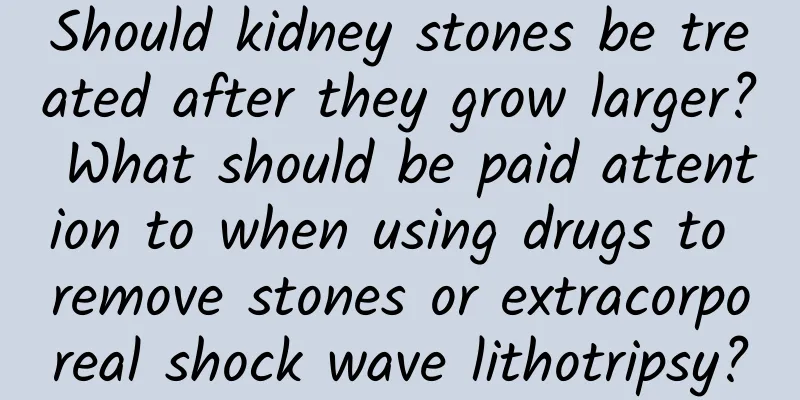Should kidney stones be treated after they grow larger? What should be paid attention to when using drugs to remove stones or extracorporeal shock wave lithotripsy?

|
Author: Zhang Yi, Chief Physician, Peking University International Hospital Reviewer: Mao Yonghui, Chief Physician, Beijing Hospital Kidney stones are hard crystals formed in the kidneys, the most common of which are calcium oxalate stones, which account for 75% or even 80% of urinary stones. There are also uric acid stones, cystine stones, and infectious stones. Clinically, the symptoms of kidney stones vary greatly. If a relatively small stone falls into the ureter and causes spasm, severe pain may occur, accompanied by microscopic or macroscopic hematuria, nausea, sweating, vomiting, etc. Figure 1 Original copyright image, no permission to reprint The stones are relatively large, but in the kidneys, the symptoms are usually mild, manifested as dull pain and distending pain in the kidney area, and some patients do not even have any discomfort. If the stones are stuck in the renal pelvis outlet or ureter, in addition to pain and hematuria, the urine secreted by the kidneys cannot be excreted smoothly, resulting in increased renal pelvic pressure, and the kidneys may gradually swell. The renal parenchyma is compressed by urine and becomes thinner, forming hydronephrosis, affecting the function of the affected kidney. In addition, even if it does not cause obvious hydronephrosis or severe renal damage, large stones can cause long-term stimulation or become a breeding ground for pathogens, which can also have adverse effects on the kidneys. For kidney stones smaller than 4-5 mm and without associated symptoms, active treatment is not required. However, for special groups, such as pilots and astronauts, the stones must be actively removed. Some people believe that even if the stones are large but there is no obvious hydronephrosis, they can be treated after they grow larger and cause hydronephrosis. This view is somewhat biased. In fact, stones can cause irritation and inflammation, which is detrimental to kidney function. If they exist for a long time, they can also induce other lesions, such as infection. In this case, it is recommended to seek professional medical evaluation to determine the diagnosis and treatment strategy. If the stones are not very large, such as less than 6 mm, the most basic method is to promote stone excretion by drinking more water. Some medicines can assist in stone excretion, such as various stone excretion decoctions, granules or granules of traditional Chinese medicine. From the perspective of Western medicine, alpha receptor blockers can promote the expansion of the middle and lower sections of the ureter and promote stone excretion. There is another situation, such as uric acid stones caused by metabolic factors, which can be treated with drug lithotripsy. Oral medications can alkalinize the urine and dissolve pure uric acid stones. How to judge whether it is uric acid stone? There are several ways to indicate uric acid stones, but they are not necessarily very accurate. For example, patients with combined hyperuricemia are more likely to have uric acid stones; because uric acid stones can transmit radiographs, stones that cannot be seen on abdominal plain films may be uric acid stones. During CT examination, the CT value of the stone can help to preliminarily determine whether it is a uric acid stone. The most accurate way is to obtain the stone and analyze its composition. If the kidney stone is less than 2 cm, extracorporeal shock wave lithotripsy can be selected. If the same kidney stone needs repeated lithotripsy treatment, it is generally required to wait for 7-10 days, and then perform the second extracorporeal shock wave lithotripsy treatment after various test indicators are normal or basically restored. Figure 2 Original copyright image, no permission to reprint If the stones do not change much after two extracorporeal shock wave lithotripsy treatments, or if satisfactory lithotripsy results are not achieved, other treatment methods are recommended, such as flexible ureteroscopy or percutaneous nephrolithotomy. This can better protect the kidneys and avoid the effects of multiple extracorporeal shock wave lithotripsy on the kidneys. If you develop kidney stones this time, extracorporeal shock wave lithotripsy will be very effective, but if the stones grow again after a few years, you can still choose extracorporeal shock wave lithotripsy if the size and location are appropriate. |
<<: What kind of kidney stones can be removed using minimally invasive methods?
>>: Diabetes self-management: the correct way to use a home blood glucose meter
Recommend
What should I do if my vagina becomes dry during sex?
Sexual life is supposed to be a very pleasant thi...
Can I open the window for ventilation during confinement?
Pregnant women need to take good care of their bo...
Why do my breasts itch? What causes my breasts to itch? What causes itching around my breasts?
Women often experience breast itching in their da...
What to do if you have bleeding in two months of pregnancy?
Many women now report that they still have vagina...
How does fennel seeds treat dysmenorrhea?
Fennel seeds can indeed help relieve dysmenorrhea...
Causes of belly button pain during pregnancy
After many of our female compatriots become pregn...
Can I cut my fingernails during confinement?
After giving birth, the mother's body often n...
Why do I have gynecological inflammation every time I have a checkup?
Gynecological inflammation is a series of disease...
Why do I fart a lot during ovulation?
The ovulation period is a stage that women must a...
Treatment for female alopecia areata, there are ways to stay away from alopecia areata
Female friends all attach great importance to the...
What causes uterine wall thickening?
Uterine wall thickening is actually the excessive...
A powerful "weapon" against cancer: scientific nutrition "escorts" the road to fighting cancer
The nutritional status of cancer patients directl...
What is labia minora enlargement?
Women have two types of labia minora and labia ma...
What does a small gestational sac and a large fetal bud mean?
Generally, women will have a small gestational sa...
Sony: 3Q17 revenue increased 12% year-on-year, operating profit increased 3.8 times
Sony's operating profit grew 3.8 times as muc...









